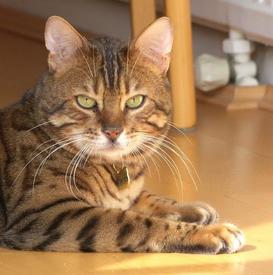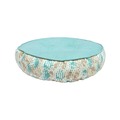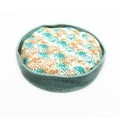
This article also relates to: Cheetoh
Forever fascinated by the idea of wild cats, the Bengal was initially bred to fulfill the desire for a safe, wild-looking domestic cat. A selective breeding program was begun by Jean S. Mill in 1963, although a breed of cat aligning with the modern Bengal is recorded as early as 1889. Besides this, precious little is known about the development of the breed, although it was officially recognised by the International Cat Association in 1991. Demand for bengals is high, and several other varieties such as the Savannah and Toyger are being developed from it.
Very distinctive in appearance, the Bengal is characterised by an athletic build, with long legs, large upright ears, a wedge-shaped head, a broad nose and a moderate length tail. The coat is typically close-fitting and seen in a variety of colours and coat patterning. Seal lynx, seal sepia and seal mink varieties with a cream or white background are known as ‘Snow’ bengals. Otherwise, a Bengal may be gold, brown, orange, rust, ivory, sand or buff, with spots that are usually chocolate brown, black, rust, charcoal or cocoa. The Bengal enjoys being in water and has been known to enter the bath or shower when its owner has been inside.
Despite being a wonderful breed in many respects, the Bengal is not a cat for the first-time owner. It is also not a suitable breed for those that work all day every day, as it needs constant attention and companionship. For this reason, it is usually wise to get two kittens at the same time. Otherwise, the breed is intelligent, energetic and affectionate, not a lap cat, but a cat that is interested in family life and is eager to participate in all that’s going on. The Bengal is also highly inquisitive and can find its way into drawers, cupboards and handbags with great ease. On average, a healthy Bengal will weigh 6-12 pounds depending on its gender, with a typical life expectancy of 12-16 years.
Various genetic health disorders are identified in the breed. These range from mild and treatable conditions, to more serious ones. In recent years, the condition autosomal recessive disorder has been well documented in the breed, a condition that causes blindness in the first year of age. Infectious diseases such as trichimonas foetus and feline infectious peritonitis are prevalent, whilst the genetic condition polycystic kidney disease is common.








From Surrey, United Kingdom
Bengals are huge fun and a joy to own provided you take the trouble to train them properly when young
From Greater Manchester, United Kingdom
Not all cats, loved to be stroked, and they chat a lot, quick to learn, but they answer back, love !y Lola. 💗
From East Sussex, United Kingdom
They hate it if you are put a lot unless in the garden when they can come along too. Ours is chatty, bossy, amusing and beautiful. We would now find t hard to have a vat whoch did not talk all day!
From Monmouthshire, United Kingdom
Haha this one is loud don’t think they won’t wake you up with their yelling at 4am. ‘Hey hoomans I’m home’
From Norfolk, United Kingdom
Very inquisitive, gets in any open cupboard, drawers,bags and loves a box. Comes out for walks in the woods with our elderly Labrador and loves to show you how quickly he can run up the trees. Intelligent, have trained him to give paw for treats and come in when biscuit box is shaken. Such an amusing cat to own but not a breed to be left home alone.
From Wiltshire, United Kingdom
I adopted Lola 4 years ago from a cat rescue . She settled in well after a few weeks with my other cat and pointer dog. Very gentle and affectionate, intelligent, vocal, presently on my lap every night which could change in the summer months, everything is on her terms! She is a hunter, often brings birds and field mice but picks them up and runs away with them when I try to take them from her. I'm not happy about her hunting but it's in cat's nature! I love her to bits!
From United Kingdom
I got Poppy as a kitten, when my previous Bengal passed away at 18 months from FIP. Very intelligent she loves to play fetch and have a chat ( she is very verbal crying like a baby) waiting for me at the door each day when I come home from work she follows me everywhere.
From United Kingdom
We got ours with his brother from a lovely home where they had been nicely socialised. Unfortunately his brother was too adventurous and was found some 2 miles away having been knocked down by a car. Spark on the other has made friends with a Bengal across the road and frequently goes visiting - they are also seen hunting together across the fields. He also loves visiting us in our home offices during the day and sleeping on my husband's lap in the evening.
From Aberdeenshire, United Kingdom
I have 2 Bengal kittens. The breeder recommended 2, rather than one, as they want to play all the time. A brown male and a snow mink female. They are beautiful kittens, but very energetic. Especially the male. They don’t sleep as much as other breeds. We love them, but we’re home all the time and can give them the attention they need. They are both lap cats, when it suits them lol!